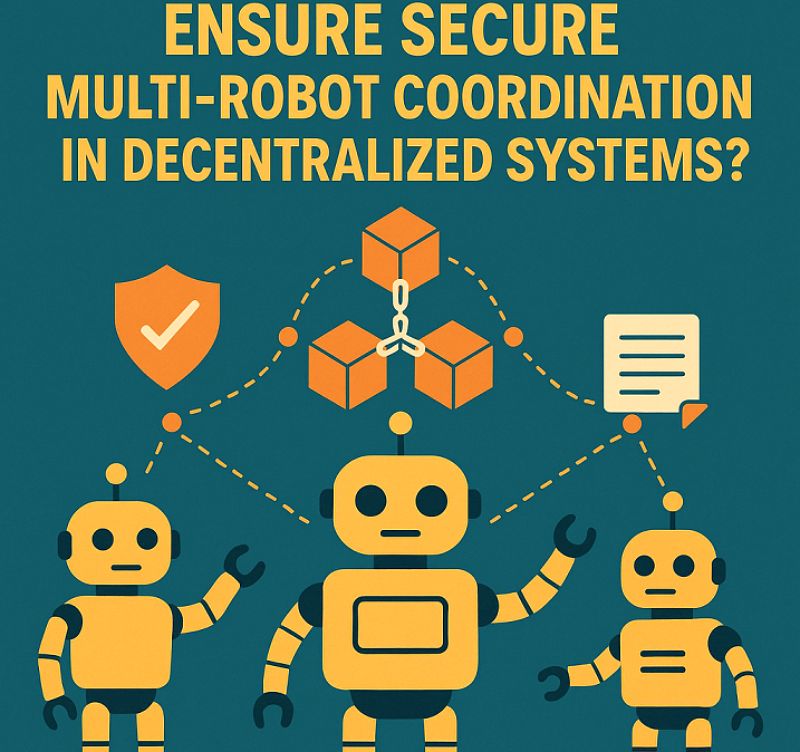Title: How Can Blockchain Ensure Secure Multi-Robot Coordination in Decentralized Systems?
Table of Contents
Intro – Wait, Robots Need to Coordinate?
What Even Is Multi-Robot Coordination?
So, Where Does Blockchain Come In?
Why Traditional Methods Kinda Suck
How Blockchain Actually Helps (Without Getting Too Nerdy)
Real-World Examples (Yes, This Is Happening)
But… Is It Really That Secure?
The Bigger Picture – Decentralization, Baby
Final Thoughts – Robots, but Make It Trustworthy
FAQs – All the Stuff You Were Probably Thinking
1. Intro – Wait, Robots Need to Coordinate?
Yeah, wild right? But think about it—robots are out here doing team stuff now. Not just Roombas bumping around your living room. We’re talking drones delivering packages, autonomous vehicles swerving through traffic, robot dogs (still creepy, btw) helping in disaster zones. These bots gotta talk to each other and stay in sync or it’s gonna be straight-up chaos.
2. What Even Is Multi-Robot Coordination?
Imagine a group project. But instead of humans flaking out, you’ve got robots who (hopefully) do their job. Multi-robot coordination is all about making sure each robot in a squad knows what it’s doing and how it fits into the group effort. Tasks are divided, paths are synced, decisions are made—ideally without anyone crashing into anyone else.
3. So, Where Does Blockchain Come In?
Okay, so here’s the tea. When you’ve got a bunch of robots doing stuff together—especially in a decentralized setup (aka no central boss telling ’em what to do)—you need trust. And not the “I believe in you, buddy” kind. You need cryptographic, tamper-proof, cross-verified, digital kind of trust. That’s where blockchain shows up like a tech superhero.
4. Why Traditional Methods Kinda Suck
Centralized coordination? Nah. Too slow, too risky, and way too easy to hack. If the “main server” goes down or gets compromised, it’s game over. Plus, robots in remote areas (like the ones helping in rural healthcare—yeah, real thing, read about it here) might not even have reliable internet 24/7.
5. How Blockchain Actually Helps (Without Getting Too Nerdy)
Think of blockchain as a shared notebook that all robots can read and write to—but no one can erase or doodle nonsense in. Every decision, sensor update, or task assignment gets logged. It’s secure, timestamped, and verified by the network. So if Bot A says “I picked up the package at 4:02 PM,” everyone knows it’s true because it got locked into the chain.
Plus, smart contracts? Game changer. Robots can have “if this, then that” rules baked in. Like, “If drone delivers package, then unlock payment.” No middleman. Just math.
6. Real-World Examples (Yes, This Is Happening)
Swarm robotics in agriculture. Think robo-bees doing synchronized crop monitoring.
Drone fleets managing search and rescue missions.
Autonomous delivery bots coordinating in real time without stepping on each other’s wheels.
And this isn’t just future talk. With stuff like 6G-powered robotic surgery and even neuromorphic hardware, we’re already pushing the envelope of what robots can do together.
7. But… Is It Really That Secure?
In theory? Yep. Blockchain is like Fort Knox for data. But in practice, it’s not 100% bulletproof. You still gotta watch for bugs in the smart contracts, or someone sneaking in compromised data (garbage in, garbage out, y’know?). Still, it beats trusting some sketchy central server.
8. The Bigger Picture – Decentralization, Baby
This isn’t just about robots. It’s a peek into how decentralized systems can operate without needing Big Brother watching over everything. It’s kind of the whole vibe of Web3, blockchain, and honestly, even multimodal AI—systems that can do more, share more, and trust each other without needing a babysitter.
9. Final Thoughts – Robots, but Make It Trustworthy
So yeah, blockchain + robots = match made in geek heaven. You get coordination without chaos, security without a central overlord, and performance that scales. Still rough around the edges, but hey—so is the internet, and look how far that’s come.
If you’re thinking “But I’m not even techy like that,” don’t worry. There are actually ways into this world even if you’re not coding 24/7. Check this out: You Can Build a Career in AI Even If You’re Non-Tech.
10. FAQs – All the Stuff You Were Probably Thinking
Q1: What is multi-robot coordination? A1: It’s like teamwork, but for robots. They share tasks, avoid crashing into each other, and complete missions together.
Q2: Why do robots even need blockchain? A2: Because trust matters. Blockchain keeps their actions verifiable and tamper-proof.
Q3: Isn’t blockchain too slow for real-time robot stuff? A3: Depends on the chain and the setup. Some are faster than others. Optimization is still a work in progress.
Q4: What happens if one robot tries to cheat? A4: It gets caught. Fast. Blockchain logs everything. Everyone sees the receipts.
Q5: Is this used in rural areas too? A5: Yep! Especially where you can’t rely on central servers. Like in rural healthcare—check this.
Q6: Do I need to understand coding to work in this space? A6: Nah. Start here: Non-Tech Careers in AI.
Q7: What’s the deal with smart contracts? A7: Think of them as robot rules on autopilot. They execute themselves. No humans needed.
Q8: Is this connected to other tech trends like quantum or 6G? A8: Oh yeah. Quantum computing and swarm robotics are a thing. Same with 6G in surgical bots.
Q9: Is blockchain the only way to secure robot coordination? A9: Nope. But it’s one of the coolest and most scalable ways.
Q10: Are we all gonna be ruled by robot swarms? A10: Not yet. But hey, if they’re on the blockchain, at least they’ll be organized.

